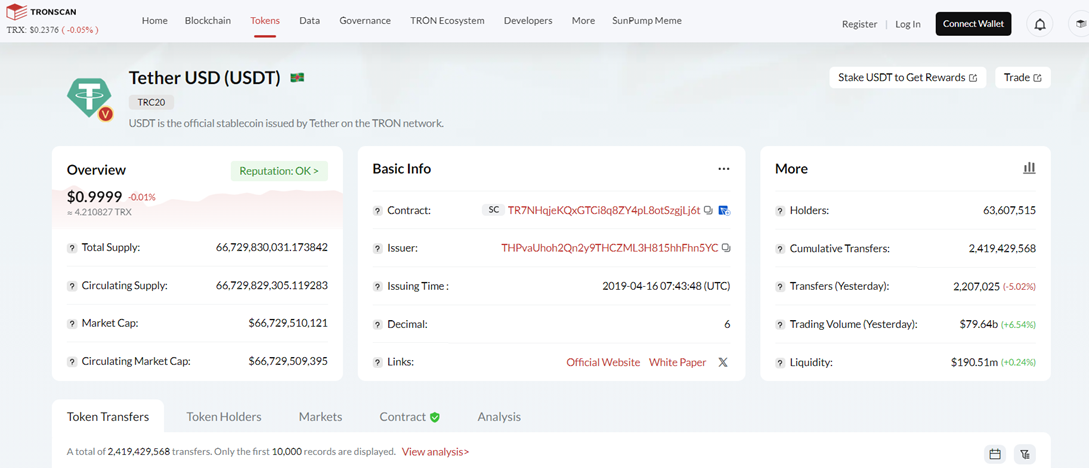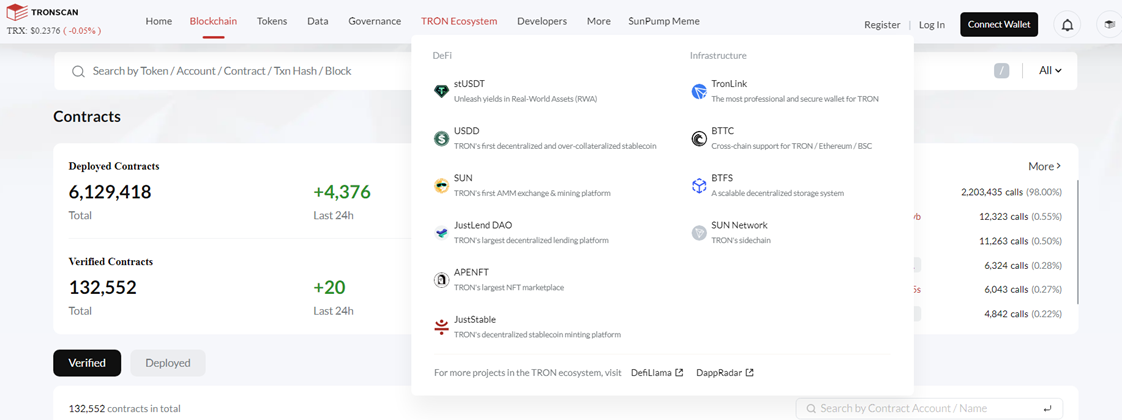How Tron Became One of the Most Popular Blockchain Networks
Since the launch of the Tron ecosystem, we have observed both ups and downs. Just a year ago, TRX was trading at $0.129, and today this figure is $0.237, following a high of $0.44 last December. Nevertheless, TRX remains in the top 10 on CoinMarketCap with a market capitalization of over $22 billion.
Cryptocurrency market analysts predict further strengthening of Tron's native crypto in 2025.
Tron has also firmly established itself in the top five of the TVL (total value locked) rankings. This indicator is crucial for assessing the investment attractiveness of blockchain projects.

Tron successfully chose one of the important niches in cryptocurrency blockchains – the use of TRC-20 tokens to create its own stablecoin based on Tether – USDT TRC-20. The network's dollar-pegged stablecoin is in huge demand. The Tron ecosystem provides almost instantaneous transactions and offers the ability to efficiently use special resources for gas fees, which significantly reduces transaction costs. Therefore, the volume of USDT TRC-20 operations here is high and steadily growing.

It's no coincidence that Tether Limited issued an additional 1 billion USDT specifically for use on the Tron blockchain. Apparently, the company was attracted by the fact that at the end of last year, USDT TRC-20 became the winner in the nomination for transactions made with stablecoins by real people, not bots. The share of such transactions exceeded 68%.
Thus, the growth of the Tron ecosystem is driven by a combination of technological innovations and strategic initiatives. Let's take a closer look at the key aspects that have contributed to Tron's success.
We explain the factors contributing to the growing popularity of the Tron network, including its technical features, strategic decisions, and low fees.
Technical Features of Tron
To get an idea of the Tron blockchain's performance, it's enough to compare its "speed" with its closest competitor, which was previously a partner:
- Tron – 2000 TPS (transactions per second);
- Ethereum – 15-30 TPS.
How is the Tron ecosystem capable of achieving such staggering results? Primarily – due to an updated blockchain architecture.
Multi-level Architecture of Tron
Tron is a public blockchain designed for developers, offering a basic infrastructure for creating smart contracts and decentralized applications, as well as free publication, ownership, and data storage. Unlike public blockchains (such as Bitcoin) that use a Proof-of-Work (PoW) consensus mechanism, TRON uses a Delegated Proof-of-Stake (DPoS) consensus mechanism.
The three-tiered blockchain structure largely provides its user-attractive characteristics and advantages.
- The storage layer manages blockchain data and transactions, ensuring secure and efficient data processing.
- The Core Layer processes smart contracts and consensus mechanisms, ensuring the seamless execution of decentralized applications (dApps).
- The application layer facilitates the development of decentralized applications and their integration into real-world use cases, stimulating ecosystem expansion. Examples include the constant introduction of new features, such as GasFree, as well as the construction of new services on the blockchain that make it easier for users to interact with smart contracts – Energy rental services, etc.
Advantages of the Tron Network Provided by its Architecture
- Flexibility and scalability – for example, the integration of Tron and BitTorrent allowed the Tron ecosystem to become one of the largest decentralized systems in the world;
- Increased performance up to 2000 transactions per second with minimal delays – unprecedented among cryptocurrency blockchains;
- Maximum possible decentralization allows for interaction with smart contracts;
- Developers can create decentralized applications (dApps) based on Tron.

Low Fees and Their Impact on Popularity
An analysis of the fee policy in the Tron network allows us to conclude that the blockchain team strives to provide participants with a choice of means for paying for transactions. Moreover, users of the ecosystem can pursue different goals and achieve them. Most aim to reduce transaction costs, but some prefer the convenience of paying without much effort.
For the former, Tron offers special resources, Energy and Bandwidth, which can be used to pay for gas instead of the native TRX crypto.
And here the team did not stop at the fact that these resources can be obtained by staking. They met users halfway who cannot or do not want to withdraw large volumes of TRX from circulation to stake Energy (600 Bandwidth units are given free to all users every day). The Tron blockchain supports the construction of services that rent out Energy.
Here is a prime example of how quickly such services are developing, using the latest API technologies. The NETTS Energy rental service was specially designed to find this resource on the market so that Tron users do not experience problems with their balance and do not spend native crypto on transactions.
Initially, only a web interface was offered, then a Telegram bot appeared, and now it is possible to connect active users who frequently interact with smart contracts via API. This is very convenient and profitable, for example, for cryptocurrency platforms that make dozens of USDT TRC-20 transfers per day.
The wallet of such a platform is connected via API, an Energy charging schedule is created – and that's it. The user just needs to decide on a trigger – the Energy level in the wallet. As soon as the level drops – NETTS recharges your wallet.

The Host mode also provides for the possibility of a constant presence of a certain amount of Energy on the client's balance or the supply of this resource in cycles.
That is, you do not need to calculate the required amount of Energy, nor check the availability of the resource before each transaction, nor worry that Energy may not be enough due to increased network congestion. And most importantly – you will not have to withdraw a large volume of native crypto for staking to get Energy. It is enough to deposit 20 TRX to connect via API.
You can also use a Telegram bot if you don't have many transfers per day. This will cost 15 TRX for a deposit.
But only payment for actually used Energy will be debited from the deposit (except for periods of Tron network overload).
Registration via the website form provides for prepayment and is designed for those who rarely transfer USDT TRC-20.
And here are screenshots that demonstrate how low the prices are at NETTS:

Why such different amounts? It's simple. A few years ago, the Tron blockchain implemented a dynamic energy consumption model. That is, network load in real time affects the gas fee. The second screenshot is an invoice for a client's wallet being charged overnight.
The savings during the day are good and have no analogues on the market – 79+%, and during periods of minimal system load – it's simply unprecedented: almost 82%!
For holders of large USDT TRC-20 assets who do not have TRX, Energy, and Bandwidth on their balance and want to transfer stablecoins without extra hassle, the GasFree function was introduced. This, of course, is more about comfort than about reducing transaction costs, since calculations here are made in stablecoins – 10 USDT per transaction for any amount and to any address. But the comfort is like transferring fiat currencies via online banking.
Conclusion
The abolition of gas fees, despite some increase in the cost of transactions for USDT transfers using the GasFree function, attracted new users. They appreciated the convenience of paying in USDT without the need to accumulate TRX and/or special resources.
The team supports Energy rental services on the Tron network, which minimize transaction fees when interacting with smart contracts.
Strategic Initiatives and Partnerships
Above, we have already mentioned some important steps Tron has taken on its path to success. Despite similarities with EOS and Ethereum, Tron distinguished itself by being adopted by major projects.
- Tether (USDT) has become one of the largest stablecoin networks, benefiting from Tron's efficient and cost-effective infrastructure.
- BitTorrent (BTT) uses the Tron blockchain to improve peer-to-peer file sharing, enhancing decentralized content distribution.
- APENFT serves as Tron's specialized NFT marketplace, facilitating the trading of digital assets and art-dedicated tokens.
- Investments in projects. In December 2024, Tron founder Justin Sun invested $30 million in World Liberty Financial, strengthening the network's position in the market.
- Expansion of functionality. The ability to waive gas fees for stablecoin transfers has made Tron more attractive for mass adoption. This capability is provided by the recently launched GasFree function.
- The blockchain's functionality is also expanding due to the team's support for various services, particularly Energy rental, which attract additional users by allowing them to reduce transaction costs, freeing them from the need to withdraw assets in the form of native crypto.
Conclusion
It is no accident that the Tron eco-platform is consistently among the leaders of cryptocurrency platforms. This was achieved through persistent work on implementing technical innovations.
Low fees and the highest transaction speed due to correct strategic decisions have allowed the Tron system to take a leading position in the world of blockchain technologies.
Its success serves as an example of how a combination of technology and business strategies can lead to mass adoption.
Join the Tron ecosystem and take advantage of its benefits today!
If you are already an active user of this blockchain but still complain about high gas fees, pay attention to how they are formed. After all, Tron provides its users with all the opportunities to reduce their transaction fees to a minimum – 3-5 times compared to paying in TRX.
To do this, you don't even need to withdraw huge amounts of native crypto from circulation to freeze them. It is much more profitable to turn to an Energy rental service built on the Tron blockchain.
Test the capabilities of the NETTS Energy rental service API. You will forever be free from problems with this resource, and 80% of the saved funds will remain with you from this moment on. Just deposit 1 TRX into your Workspace – and explore the possibilities of your personal account. We are sure we will meet again: all testers are now NETTS clients. People get used to good and profitable things instantly.